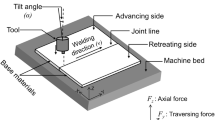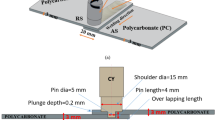Abstract
Detection of defects in friction stir welding process is a challenging task since most of the defects are internal or subsurface. An attempt has been made to explore the methodologies based on temperature signal for possible detection of defects in friction stir welding process using different tool profiles. The presence of defect is affected by temperature diffusion and is better reflected by the change of temperature over time. Temperature signals are acquired using thermocouples inserted in specific locations on advancing and retreating side of the welds. The rate of change of temperature and wavelet-analysis-based indicator computed from temperature signal against each experiment reveal appreciable difference for defective and defect-free welds. Threshold values are computed that clearly set a boundary for classifying the defective welds from defect-free welds. The proposed approaches can effectively reduce the post-processing steps essential for other non-destructive evaluation of the welds and can work as a first level of safeguard in the identification of defects during friction stir welding process. The methodologies can be extended towards monitoring of the process in industrial applications.





Similar content being viewed by others
References
Kim Y G, Fujii H, Tsumura T, et al 2006 Three defect types in friction stir welding of aluminium die casting alloy. Mater. Sci. Eng. A 415: 250–254
Boldsaikhan E, Corwin E M, Logar A M and Arbegast W J 2011 The use of neural network and discrete Fourier transform for real-time evaluation of friction stir welding. Appl. Soft Comput. 11: 4839–4846
Saravanan T, Lahiri B B, Arunmuthu K, et al 2014 Non-destructive evaluation of friction stir welded joints by X-ray radiography and infrared thermography. Proc. Eng. 86: 469–475
Chen H B, Yan K and Lin T 2006 The investigation of typical welding defects for 5456 aluminium alloy friction stir welds. Mater. Sci. Eng. A 433: 64–69
Rosado L S, Santos T G, Piedade M, et al 2010 Advanced technique for non-destructive testing of friction stir welding of metals. Measurement 43: 1021–1030
Iwaki S, Okada T, Eguchi N, Tanaka S, Namba K and Oiwa N 2006 Imperfections in friction stir welded zones and their precision non-destructive testing. Studies on characteristics of friction stir welded joints in structural thin aluminium alloys. Weld. Int. 20: 197–205
Cosmi F, Cristofori A and Mancini L 2005 Preliminary investigation by synchrotron radiation of cracks and defects in AA FSW samples. In: Proceedings of the 11th International Conference on Fracture, Paper No. 5450, Turin, Italy
Moles M, Lamarre A and Cancre F 2002 Utilization of state-of-the-art phased array inspection technology for the evaluation of friction stir welds. In: Proceedings of NDE 2002: Predict, Assure, Improve, Chennai, India
Moles M, Lamarre A and Dupuis O 2004 Complete inspection of friction stir welds in aluminium using ultrasonic and eddy currents arrays. In: Proceedings of 16th WCNDT 2004 – World Conference on NDT, Montreal Canada, Paper No 84
Wu C S, Wang L, Ren W J and Zhang X Y 2014 Plasma arc welding: process, sensing, control and modeling. J. Manuf. Process. 16(1): 74–85
Huang X and Chen S 2006 SVM-based fuzzy modeling for the arc welding process. Mater. Sci. Eng. A 427(1–2): 181–187
He K, Li Q and Chen J 2013 An arc stability evaluation approach for SW AC SAW based on Lyapunov exponent of welding current. Measurement 46(1): 272–278
Zhang Z, Chen H, Xu Y, Zhong J, Lv N and Chen S 2015 Multisensor-based real-time quality monitoring by means of feature extraction, selection and modelling for Al alloy in arc welding. Mech. Syst. Signal Process. 60–61: 151–165
Cavaliere P, Campanile G, Panella F, et al 2006 Effect of welding parameters on mechanical and microstructural properties of AA6056 joints produced by friction stir welding. J. Mater. Process. Technol. 180: 263–270
Arora K S, Pandey S, Schaper M and Kumar R 2010 Effect of process parameters on friction stir welding of aluminum alloy 2219-T87. Int. J. Adv. Manuf. Technol. 50: 941–952
Yang Y, Kalya P and Landers R G 2008 Automatic gap detection in friction stir butt welding operations. Int. J. Mach. Tool. Manuf. 48: 1161–1169
Chen C, Kovacevic R and Jandgric D 2003 Wavelet transform analysis of acoustic emission in monitoring friction stir welding of 6061 aluminium. Int. J. Mach. Tool. Manuf. 43: 1383–1390
Soundararajan V, Atharifar H and Kovacevic R 2006 Monitoring and processing the acoustic emission signals from the friction stir welding process. Proc. IMechE Part B J. Eng. Manuf. 220: 1673–1685
Mehta M, Chatterjee K and De A 2013 Monitoring torque and traverse force in friction stir welding from input electrical signatures of driving motors. Sci. Technol. Weld. Join. 18: 191–197
Das B, Pal S and Bag S 2014 Monitoring of friction stir welding process through signals acquired during the welding. In: Proceedings of the 5th International and 26th All India Manufacturing, Design and Research Conference (AIMTDR2014), December 12–14, 2014, Assam, India
Bhat N N, Kumari K and Dutta S 2015 Friction stir weld classification by applying wavelet analysis and support vector machine on weld surface images. J. Manuf. Process. 20(1): 274–281
Das B, Pal S and Bag S 2016 Defect detection in friction stir welding process through characterization of signals by fractal dimension. Manuf. Lett. 7: 6–10
Shrivastava A, Dingler C, Zinn M and Pfefferkorn F E 2015 Physics-based interpretation of tool–workpiece interface temperature signals for detection of defect formation during friction stir welding. Manuf. Lett. 5: 7–11
Khandkar M Z H, Khan J A and Reynolds A P 2003 Prediction of temperature distribution and thermal history during friction stir welding: input torque based model. Sci. Technol. Weld. Join. 8(3): 165–174
Fuller M D, Swaminathan S, Zhilyaev A P and McNelley T R 2007 Microstructural transformations and mechanical properties of cast NiAl bronze: effects of fusion welding and friction stir processing. Mater. Sci. Eng. A 463: 128–137
Shirazi H, Kheirandish S and Safarkhanian M A 2015 Effect of process parameters on the macrostructure and defect formation in friction stir lap welding of AA5456 aluminium alloy. Measurement 76: 62–69
Chen Z W, Pasang T and Qi Y 2008 Shear flow and formation of nugget zone during friction stir welding of aluminium alloy 5083-O. Mater. Sci. Eng. A 474: 312–316
Saeid T, Abdollah-zadeh A, Assadi H, et al 2008 Effect of friction stir welding speed on microstructure and mechanical properties of a duplex stainless steel. Mater. Sci. Eng. A 496: 262–268
Morisada Y, Imaizumi T and Fujii H 2015 Clarification of material flow and defect formation during friction stir welding. Sci. Technol. Weld. Join. 20: 130–137
Guasp M R, Daviu A A, Sanchez M P, Panadero R P and Cruz J P 2008 A general approach for transient detection of slip-dependent fault components based on the discrete wavelet transform. IEEE Trans. Ind. Electron. 55: 4167–4180
Pal S, Pal S K and Samantaray A K 2008 Neurowavelet packet analysis based on current signature for weld joint strength prediction in pulsed metal inert gas welding process. Sci. Technol. Weld. Join. 13: 638–645
Mishra R S and Ma Z Y 2005 Friction stir welding and processing. Mater. Sci. Eng. R 50: 1–78
Acknowledgements
The authors gratefully acknowledge the financial support provided by SERB (Science and Engineering Research Board), India (Grant No. SERB/F/2767/2012-13), to carry out this research work.
Author information
Authors and Affiliations
Corresponding author
Rights and permissions
About this article
Cite this article
Das, B., Pal, S. & Bag, S. Probing defects in friction stir welding process using temperature profile. Sādhanā 44, 79 (2019). https://doi.org/10.1007/s12046-019-1068-2
Received:
Accepted:
Published:
DOI: https://doi.org/10.1007/s12046-019-1068-2




